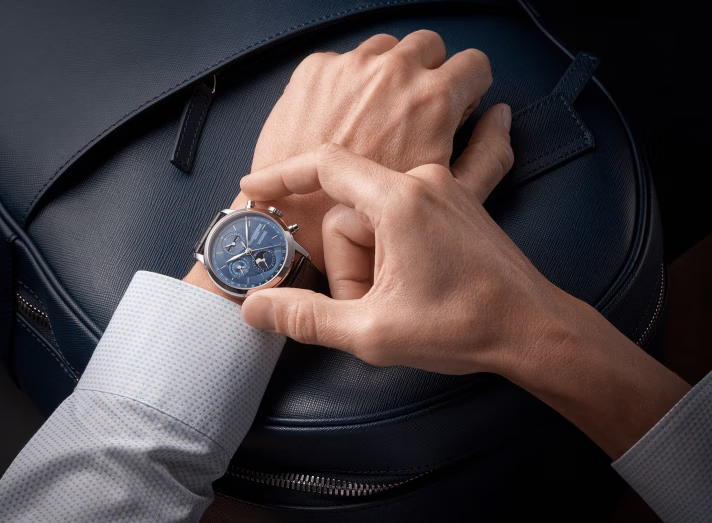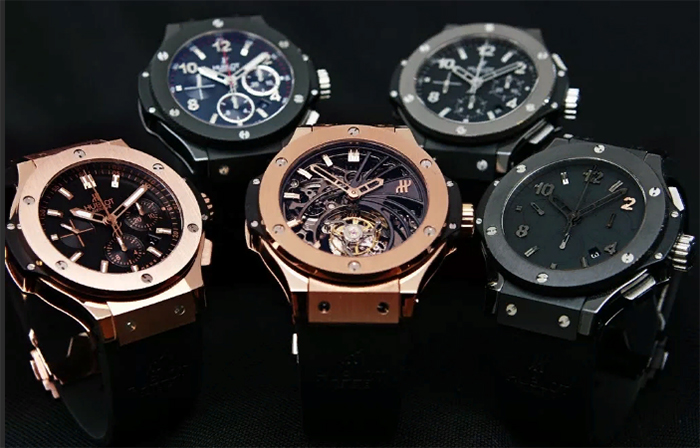Introduction
The world of luxury watches is a realm where tradition meets innovation, and craftsmanship speaks volumes about a brand’s dedication to precision and excellence. Two Swiss watchmaking names that have carved out their own distinctive identities over the years are Hublot and Baume & Mercier. Though both brands hail from Switzerland, they each represent different approaches to watchmaking, design, and history. Hublot, a relatively young brand, is known for its avant-garde materials and bold designs, while Baume & Mercier, with its centuries-old heritage, stands as a symbol of timeless elegance and Swiss tradition.
The question, then, is: How do Hublot and Baume & Mercier compare in terms of their brand histories, legacies, and their evolution within the luxury watch industry? This article will delve into the histories of both brands, their unique contributions to watchmaking, their cultural impacts, and how they differ in their approaches to design, innovation, and craftsmanship.
Chapter 1: Hublot – The Brand That Revolutionized Luxury Watchmaking
1.1 Origins and Foundation of Hublot
Founded in 1980 by Carlo Crocco, Hublot was an entirely new player in the Swiss watch industry. It wasn’t just another luxury watchmaker trying to sell watches with traditional designs; it was a brand built on breaking the mold. Carlo Crocco, an Italian entrepreneur with a background in fashion, wanted to create something radically different. His vision for Hublot was clear: a watch that combined Swiss precision with bold, contemporary design.
The brand’s first release, the Hublot Classic, introduced a revolutionary combination of gold and rubber. The idea of using rubber, a material more commonly associated with sport or casual wear, in a luxury timepiece was seen as a groundbreaking innovation. This was the first significant step in Hublot’s commitment to the “Art of Fusion”, a concept that would define its future.
1.2 The Hublot Identity – The Art of Fusion
The brand’s “Art of Fusion” philosophy was not just a marketing slogan but the bedrock of its identity. By incorporating unconventional materials such as ceramic, titanium, and carbon fiber into luxury watches, Hublot differentiated itself from the more traditional Swiss watchmakers. This strategy was designed to appeal to a younger, more fashionable crowd and was a deliberate effort to merge the worlds of luxury, sports, and fashion.
Hublot’s most famous model, the Big Bang, released in 2005, encapsulated the brand’s bold, avant-garde spirit. The Big Bang featured a mix of ceramic, rubber, and gold that took the watchmaking world by storm. Its angular, oversized case challenged the typical round designs of traditional Swiss watches and was immediately recognized as a symbol of modern luxury.
1.3 Hublot’s Revolutionary Contributions to Watchmaking
Hublot has become known not only for its cutting-edge materials and designs but also for its technological innovations. For example, the brand’s in-house movements like the UNICO chronograph and the MP-05 La Ferrari have been major milestones in the industry. The MP-05, with its 11-day power reserve and 5 barrels, pushed the boundaries of what was thought possible in mechanical timekeeping.
The brand also introduced sapphire crystal cases and titanium ceramic composites to their watches, which were revolutionary at the time of their release. Hublot’s willingness to experiment with materials has placed it at the forefront of the luxury sports watch segment, attracting a following that appreciates the brand’s commitment to innovation and artistic design.
1.4 Hublot’s Cultural Impact and Popularity
Hublot’s association with high-profile events has significantly enhanced its visibility and cultural impact. The brand is the official timekeeper for events such as the FIFA World Cup, Formula 1, and has partnerships with the NBA, as well as celebrities like Usain Bolt, Kobe Bryant, and Jay-Z. These collaborations not only increased Hublot’s global presence but also helped establish it as a symbol of modern luxury.
The brand’s bold designs and strategic celebrity endorsements allowed it to attract a new generation of luxury watch collectors and aficionados, many of whom had previously been indifferent to traditional Swiss watchmaking.

Chapter 2: Baume & Mercier – The Legacy of Swiss Tradition and Elegance
2.1 The Origins and Foundation of Baume & Mercier
Founded in 1830 by brothers Louis-Victor and César Baume in the Swiss Jura region, Baume & Mercier represents a completely different aspect of Swiss watchmaking: timeless elegance and refined craftsmanship. In contrast to Hublot’s emphasis on bold materials and modern designs, Baume & Mercier has remained rooted in traditional Swiss watchmaking values.
From the very beginning, Baume & Mercier set out to create timepieces that were not just functional but also beautiful, designed with the utmost attention to detail and quality. By the 1850s, the company had already earned a reputation for precision and reliability and began to expand into international markets.
2.2 Baume & Mercier’s Design Philosophy and Contributions
Unlike Hublot, which focuses on avant-garde design, Baume & Mercier has maintained a more classic and timeless approach to watchmaking. The brand is known for producing watches that embody elegance and sophistication. Baume & Mercier’s collections, such as the Clifton, Hampton, and Riviera, all feature refined aesthetics, combining Swiss craftsmanship with modern design elements that make them both versatile and timeless.
Baume & Mercier has consistently produced watches that cater to customers seeking luxury without the flashiness that accompanies some of today’s more modern designs. The brand’s watches are marked by clean lines, sober dials, and high-quality finishes, all of which convey a sense of refinement and understated luxury.
2.3 Baume & Mercier’s Commitment to Craftsmanship
Baume & Mercier has long been dedicated to the principles of Swiss craftsmanship. Its use of ETA movements, which are renowned for their reliability and accuracy, ensures that the brand’s watches perform as well as they look. The brand’s commitment to traditional watchmaking means that Baume & Mercier timepieces are often regarded as classics, revered for their longevity and attention to detail.
One of Baume & Mercier’s most notable contributions to watchmaking has been the introduction of complicated movements into their collections. Their Clifton 1830 model, for example, pays tribute to the brand’s early heritage and is an embodiment of their approach to sophisticated simplicity.
2.4 Baume & Mercier’s Global Legacy
Baume & Mercier has always been aligned with elegance and refinement. While it may not have the same global spotlight as brands like Hublot or Rolex, Baume & Mercier holds a significant place in watchmaking history. The brand has managed to stay true to its heritage while appealing to modern consumers who value classic designs and Swiss precision.
Baume & Mercier has built a loyal following among those who appreciate a brand that represents timeless luxury rather than trends. The watches from Baume & Mercier are often passed down through generations, making them symbols of legacy and heritage.
Chapter 3: Comparing the Brand Histories and Legacies of Hublot and Baume & Mercier
3.1 Philosophical Divergence – Innovation vs. Tradition
The most striking difference between Hublot and Baume & Mercier lies in their design philosophies and approaches to watchmaking:
- Hublot is a brand built on innovation, boldness, and the willingness to push boundaries. Its commitment to avant-garde materials like rubber, titanium, and ceramic defines its identity. Hublot’s goal is to create watches that are both functional and fashion-forward, aimed at those who seek to make a statement with their timepieces.
- Baume & Mercier, on the other hand, focuses on refinement, heritage, and traditional craftsmanship. Its watches are not about making a bold statement but about celebrating elegance, timelessness, and subtle luxury. Baume & Mercier offers a quieter, more discreet form of luxury, one that appeals to individuals who appreciate quality craftsmanship without the need for flashy designs.
3.2 Market Position and Target Audience
While both brands cater to the luxury market, their target audiences differ significantly:
- Hublot appeals primarily to the modern, fashion-conscious individual who values innovation, sportiness, and bold designs. Its collaborations with athletes and celebrities position Hublot as a brand that resonates with youthful energy, prestige, and performance.
- Baume & Mercier caters to a more traditional audience that values heritage, elegance, and classical watchmaking. Its customer base tends to be more discerning, preferring understated luxury over the flashiness associated with modern trends.
3.3 Cultural Impact and Global Recognition
- Hublot has made a significant impact on global pop culture. Its associations with sports events like the FIFA World Cup and Formula 1, as well as its partnerships with global celebrities, have helped elevate the brand to international acclaim. Its watches are seen as fashion-forward statements of modern luxury.
- Baume & Mercier, while not as loud in its marketing efforts, has built a reputation as a brand that stands for timeless elegance and Swiss precision. Its cultural impact is less about global recognition and more about legacy, as Baume & Mercier’s watches are often passed down through generations, symbolizing heritage and refinement.
Conclusion
In comparing Hublot and Baume & Mercier, we see two brands that embody different aspects of the Swiss watchmaking tradition. Hublot represents modernity, innovation, and the art of breaking boundaries with bold design choices and avant-garde materials, while Baume & Mercier offers timeless elegance, traditional craftsmanship, and a more understated approach to luxury.
Each brand has made its own mark on the world of watchmaking, appealing to different tastes and preferences. Hublot has changed the way we think about luxury sports watches, while Baume & Mercier remains a symbol of Swiss refinement and timeless beauty. Depending on your personal taste, the choice between Hublot and Baume & Mercier will ultimately come down to your values—whether you lean toward bold innovation or classic sophistication.





































